
Compass projects lower qualifying scores for the Class of 2027
The junior year PSAT is also the NMSQT — the National Merit Scholarship Qualifying Test. Each year, National Merit recognizes the top 57,000 test takers. In order to be included in that group, students need to be among the top 4% of the 1.4 million students who take the PSAT. Of that elite group, approximately 17,000 are recognized as Semifinalists for having the highest scores within their states. Semifinalists have the opportunity to continue in the program to become Finalists and, potentially, scholarship recipients. The remaining 40,000 students are recognized as Commended Students. More information can be found in our National Merit Explained post.
For the Class of 2027, the exact scores needed to qualify (“cutoffs”) will not be released until September 2026 (the Commended cutoff is likely to leak in April). In order to give students context for their test results, Compass has analyzed the scores from the October 2025 to produce estimates for the national Commended cutoff and the individual state cutoffs. We predict that the majority of state cutoffs will decline this year.
National Merit uses the Selection Index (SI), found on the PSAT score report, to rank students. The Selection Index can be calculated by doubling the Reading & Writing score (RW), adding the Math score (M), and dividing that sum by 10. For example, a student with a 720 RW and 700 M score has a Selection Index of 214 — (720 x 2 + 700)/10. The weighting of the index means that not all students with a 1420 Total Score have the same SI. A student with a 700 RW and 720 M has a Selection Index of 212. The highest SI a student can receive is 228 (760 RW and 760 M). Last year, the Commended cutoff was 210, and Semifinalist cutoffs ranged from 210 to 225 depending on the competitiveness of the state.
Why do we foresee lower cutoff scores?
College Board does not release any information about the distribution of Selection Indexes, but it does produce summaries of broad score ranges. The number of students in the 1400 – 1520 Total Score range has proved to be an excellent indicator of the Commended cutoff. The Class of 2027 saw 16% fewer top scores than did last year’s class. The 52,400 students at 1400 and above is closer to what we saw two years ago with the Class of 2025 and, going back further, similar to the results for the Classes of 2017 and 2021.
Most of the students who will qualify for National Merit recognition fall in the 1400 – 1520 band (or just outside it). With approximately 10,000 fewer students in the top band of scores this year, we expect the Commended level to drop to 208 or 209. The chart below shows the historical relationship between high scores and the Commended cutoff.
Explaining why last year’s cutoffs reached record levels
After examining this year’s numbers, we also have a better understanding of why Semifinalist cutoffs jumped to such extreme levels last year, and why it should not happen again. The 2024 PSAT saw an unprecedented 18% jump in the number of high Reading & Writing scores (700-760). The weighting of RW in the Selection Index magnified the impact of that change. The table below shows scores for the last three years and how results have fluctuated.
On the 2025 PSAT, the number of high RW scores dropped by 27%. In fact, the RW count for this year is even lower than it was two years ago. The decline in RW scores could even produce Selection Indexes lower than those in the Class of 2025 — at least in some states. The Commended cutoff may provide additional insight in the spring.
The ratio of 700+ M scores to 700+ RW scores reveals just how bizarre last year’s spike was. Traditionally, Math scores have higher distributions at the extremes. There are more very high Math scores on the PSAT and SAT, and there are more very low Math scores.
On the October 2024 PSAT, though, almost as many students scored 700-760 on RW as did on Math. The ratio of high Math scores to high RW scores was 1.02. This helps explain why some cutoffs went as high as 224 and 225 for the first time ever. Students achieved 750 and 760 RW scores in record numbers. In most years, there would be more students scoring 730 RW and 760 M (222 SI), for example, than scoring 760 RW and 730 M (225 SI). That was not true in the the Class of 2025, where there was a more equal distribution. It appears that scores for the Class of 2027 have returned to the traditional Math-heavy distribution. The ratio of high Math scores to high RW scores was 1.33 on the 2025 PSAT/NMSQT. For this reason, we don’t believe we will see a repeat of the 224 and 225 cutoffs seen last year.
Was last year a fluke, shift, or a trend?
The results from the Class of 2027 have answered one of the nagging questions from last year: Were the high cutoffs a fluke, shift, or trend? The answer appears to be fluke. More accurately, results could be labeled an error in test construction and scaling. There is no evidence that the Class of 2026 possessed special test-taking skills. As sophomores, that class performed in line with expectations on the 2023 PSAT. There is no evidence that the Class of 2027 has diminished skills. As sophomores, the class saw the same inflated scores as did the juniors on the 2024 PSAT. The best explanation is that College Board lost control of the scale. College Board dramatically shortened the PSAT when it switched from paper to digital. On the paper test, the Reading and Writing sections had 91 questions, and students were given 95 minutes. The RW on the digital PSAT is truncated to 54 questions over 64 minutes. And only 50 of the questions count toward a student’s score! A shorter exam means a less reliable exam. We saw the occasional wild ride on the paper PSAT, but the rides may get wilder and more frequent on the digital PSAT.
We anticipate the majority of state Semifinalist cutoffs to decline for the Class of 2027. Knowing this overall trend, however, doesn’t tell us which states will be in that majority or how much lower scores will go. The table below provides a Most Likely cutoff score, but the more useful information is the Estimated Range. Almost all cutoffs should fall within that range.
State | Class of 2027 (Most Likely) | Class of 2027 (Est. Range) | Class of 2026 (Actual) | Class of 2025 (Actual) | Class of 2024 (Actual) | Avg NMSFs |
|---|---|---|---|---|---|---|
| Alabama | 213 | 210 - 216 | 214 | 212 | 210 | 250 |
| Alaska | 214 | 210 - 216 | 215 | 214 | 209 | 35 |
| Arizona | 218 | 215 - 220 | 218 | 217 | 216 | 398 |
| Arkansas | 213 | 210 - 216 | 215 | 213 | 210 | 143 |
| California | 223 | 220 - 224 | 224 | 221 | 221 | 2,115 |
| Colorado | 218 | 216 - 221 | 219 | 218 | 216 | 286 |
| Connecticut | 222 | 220 - 223 | 223 | 221 | 221 | 175 |
| Delaware | 219 | 218 - 221 | 220 | 219 | 219 | 44 |
| Florida | 217 | 216 - 220 | 219 | 217 | 216 | 999 |
| Georgia | 219 | 217 - 221 | 220 | 218 | 217 | 602 |
| Hawaii | 218 | 215 - 220 | 219 | 217 | 217 | 62 |
| Idaho | 214 | 211 - 217 | 215 | 213 | 211 | 96 |
| Illinois | 220 | 218 - 222 | 222 | 220 | 219 | 704 |
| Indiana | 217 | 214 - 219 | 218 | 217 | 216 | 313 |
| Iowa | 213 | 211 - 216 | 214 | 212 | 210 | 145 |
| Kansas | 216 | 213 - 219 | 216 | 215 | 214 | 144 |
| Kentucky | 214 | 211 - 217 | 214 | 213 | 211 | 201 |
| Louisiana | 215 | 212 - 218 | 216 | 214 | 214 | 222 |
| Maine | 215 | 212 - 217 | 217 | 214 | 213 | 55 |
| Maryland | 223 | 221 - 225 | 224 | 222 | 221 | 308 |
| Massachusetts | 223 | 221 - 225 | 225 | 223 | 222 | 318 |
| Michigan | 219 | 216 - 220 | 220 | 218 | 217 | 485 |
| Minnesota | 218 | 216 - 220 | 219 | 217 | 216 | 279 |
| Mississippi | 213 | 210 - 215 | 213 | 212 | 209 | 155 |
| Missouri | 216 | 213 - 218 | 217 | 215 | 214 | 289 |
| Montana | 211 | 208 - 214 | 213 | 209 | 209 | 47 |
| Nebraska | 213 | 210 - 216 | 214 | 211 | 210 | 105 |
| Nevada | 214 | 211 - 217 | 214 | 214 | 211 | 168 |
| New Hampshire | 217 | 214 - 219 | 219 | 217 | 215 | 60 |
| New Jersey | 223 | 222 - 225 | 225 | 223 | 223 | 451 |
| New Mexico | 211 | 208 - 214 | 210 | 211 | 207 | 104 |
| New York | 221 | 219 - 223 | 223 | 220 | 220 | 1,012 |
| North Carolina | 219 | 216 - 221 | 220 | 218 | 217 | 510 |
| North Dakota | 210 | 207 - 212 | 210 | 210 | 207 | 30 |
| Ohio | 218 | 215 - 220 | 219 | 217 | 216 | 538 |
| Oklahoma | 212 | 208 - 214 | 212 | 211 | 208 | 204 |
| Oregon | 218 | 215 - 220 | 219 | 216 | 216 | 188 |
| Pennsylvania | 220 | 217 - 222 | 221 | 219 | 219 | 596 |
| Rhode Island | 217 | 214 - 220 | 219 | 217 | 215 | 47 |
| South Carolina | 214 | 210 - 217 | 215 | 214 | 209 | 236 |
| South Dakota | 210 | 207 - 213 | 211 | 208 | 209 | 42 |
| Tennessee | 218 | 215 - 219 | 219 | 217 | 217 | 319 |
| Texas | 221 | 218 - 222 | 222 | 219 | 219 | 1,623 |
| Utah | 212 | 210 - 216 | 213 | 211 | 209 | 196 |
| Vermont | 215 | 211 - 217 | 216 | 215 | 212 | 28 |
| Virginia | 222 | 220 - 224 | 224 | 222 | 219 | 437 |
| Washington | 222 | 220 - 224 | 224 | 222 | 220 | 348 |
| West Virginia | 209 | 207 - 212 | 210 | 209 | 207 | 64 |
| Wisconsin | 214 | 213 - 217 | 215 | 214 | 213 | 292 |
| Wyoming | 209 | 207 - 212 | 210 | 209 | 207 | 24 |
| District of Columbia | 223 | 222 - 225 | 225 | 223 | 223 | 36 |
| Territories | 209 | 207 - 211 | 210 | 208 | 207 | 39 |
| Outside US | 223 | 222 - 225 | 225 | 223 | 223 | 86 |
| Commended | 209 | 207 - 210 | 210 | 208 | 207 |
How cutoffs are determined
Qualifying scores (“cutoffs”) are not based on the total score for the PSAT (360-1520) but on the Selection Index, which is calculated by doubling the RW score, adding the Math score, and then dividing the sum by 10. The maximum Selection Index is 228. Students can find a historical set of cutoff data here or see how Semifinalist and Commended counts have changed state by state.
We estimate that the Semifinalist cutoffs will range from 209 to 223. Semifinalists are allocated by state, and cutoffs are calculated by state. If Florida is allocated 1,000 Semifinalists based on its population of high school graduates, then NMSC works down from a perfect 228 Selection Index until it gets as close as possible to that target. Last year, 1,008 students scored at or above the cutoff of 219. A cutoff of 220 would have produced too few Semifinalists. A cutoff of 218 would have gone over the allocation. Because score levels can get crowded, it is easy for cutoffs to move up or down a point even when there is minimal change in testing behavior or performance.
Why does each state have its own Semifinalist cutoff if the program is NATIONAL Merit?
This is always a hot button question. NMSC allocates the approximately 17,000 Semifinalists among states based on the number of high school graduates. That way, students across the nation are represented. It also means that there are very different qualifying standards from state to state. A Massachusetts student with a 220 might miss out on being a Semifinalist. If she lived 10 miles away in New Hampshire, she would qualify.
No Semifinalist cutoff can be lower than the national Commended level. Cutoffs for the District of Columbia and for U.S. students studying abroad are set at the highest state cutoff (typically New Jersey). The cutoff for students in U.S. territories and possessions falls at the Commended level each year. Boarding schools are grouped by region. The cutoff for a given region is the highest state cutoff within the region.
Change is always the theme
Over the last two decades, at least half of the state cutoffs have changed each year. In some years, as many as 49 states saw ups or downs, usually because of questionable test forms. In addition to last year’s exam, the PSATs from 2011 (Class of 2013), 2016 (Class of 2018), and 2019 stand out as problematic. The anomalous 2019 results could be traced back to a particularly mis-scaled form, which I wrote about at the time. The Class of 2014 also saw significant changes, but those were more of a bounce-back from the previous year. The question for the Class of 2027 is how much of a bounce-back will be seen this year.
Cutoffs are particularly bumpy in states with smaller pools of test takers and National Merit Semifinalists. Over the last dozen years, cutoffs in the 12 largest states have remain unchanged 36% of the time, while the cutoffs in the smallest states have remain unchanged only 1 time out of every 5. No large state’s cutoff has jumped by more than 3 points in a year, whereas 6-point changes have occurred in the pool of smaller states.
When are National Merit Semifinalists announced?
The lists of Semifinalists will not be distributed to high schools until the end of August 2026. With the exception of homeschoolers, students do not receive direct notification. NMSC asks that schools not share the results publicly until the end of the press embargo in mid-September, but schools are allowed to notify students privately before that date. NMSC does not send Commended Student letters to high schools until mid-September. Compass will keep students updated on developments as the dates approach.
Do state and national percentiles indicate whether a student will be a National Merit Semifinalist?
No! Approximately 1% of test takers qualify as Semifinalists each year, so it is tempting to view a 99th percentile score as indicating a high enough score — especially now that College Board provides students with percentiles by state. There are any number of flaws that rule out using percentiles as a quick way of determining National Merit status.
- Percentiles are based on section scores or total score, not Selection Index
- Percentiles are rounded. There is a large difference, from a National Merit perspective, between the top 0.51% and the top 1.49%
- Percentiles reveal the percentage of students at or below a certain score, but the “at” part is important when NMSC is determining cutoffs.
- The number of Semifinalists is based on the number of high school graduates in a state, not the number of PSAT takers. Percentiles are based on PSAT takers. States have widely varying participation rates.
- Most definitive of all: Percentiles do not reflect the current year’s scores! They are based on the prior 3 years’ performance. They are set even before the test is given. And if you are going to use prior history, why not use the record of prior National Merit cutoffs rather than the highly suspect percentiles?
Entry requirements for National Merit versus qualifying for National Merit.
Your PSAT/NMSQT score report tells you whether you meet the eligibility requirements for the NMSP. In general, juniors taking the October PSAT are eligible. If you have an asterisk next to your Selection Index, it means that your answers to the entrance questions have made you ineligible. Your answers are conveniently noted on your score report. If you think there is an error, you will also find instructions on how to contact NMSC. Meeting the eligibility requirements simply means that your score will be considered. Approximately 1.4 million students enter the competition each year. Only about 55,000 students will be named as Commended Students, Semifinalists, Finalists, or Scholars. See National Merit Explained for more information.

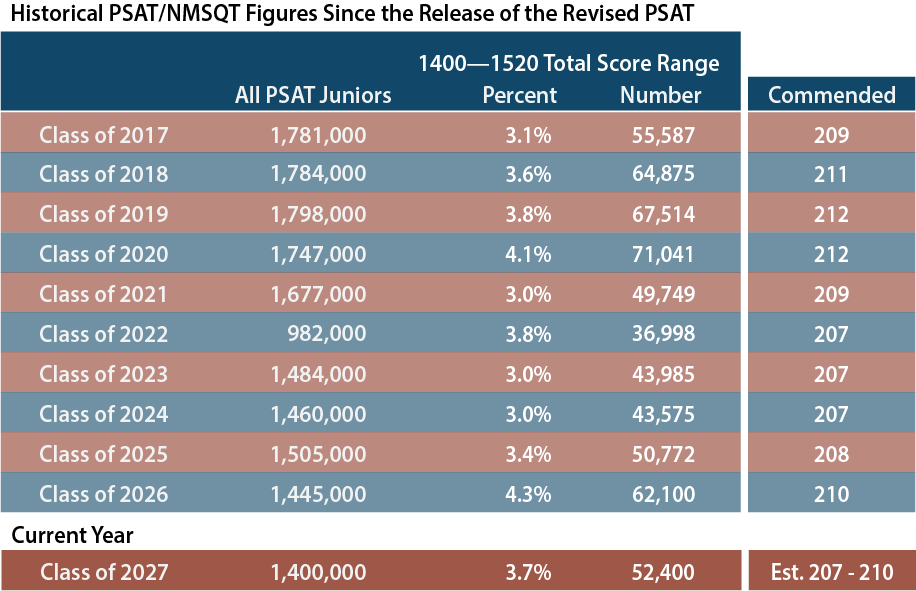
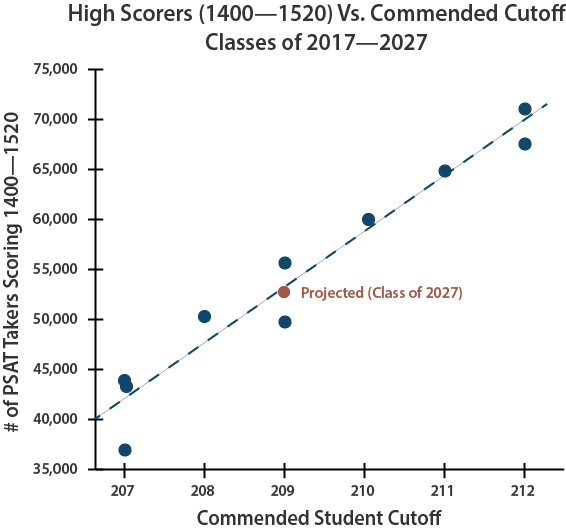


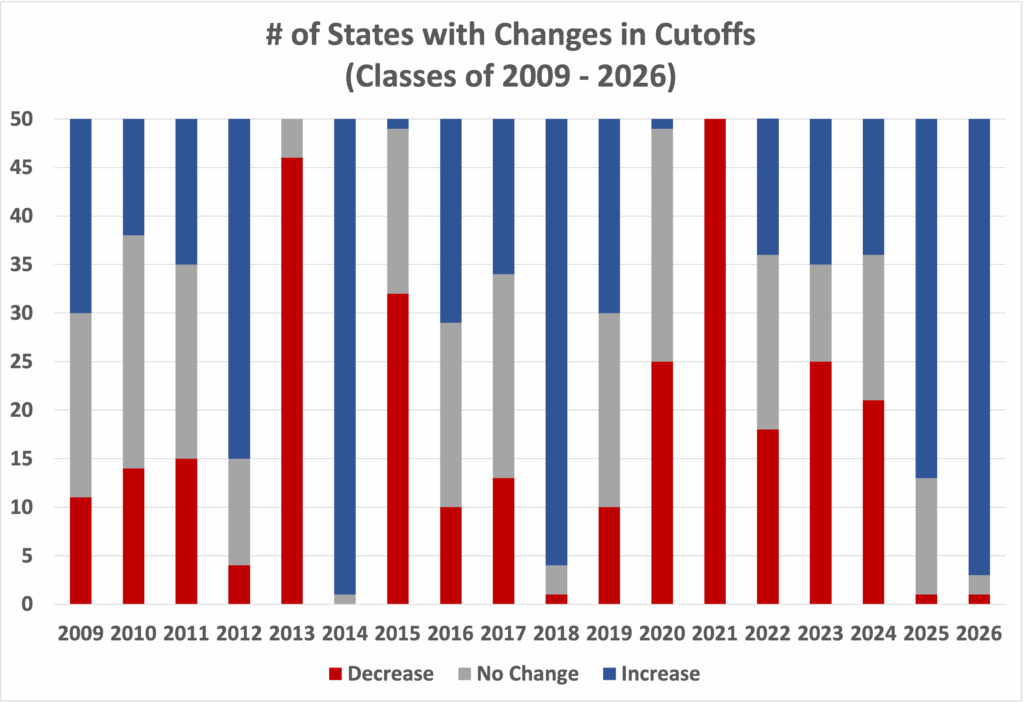
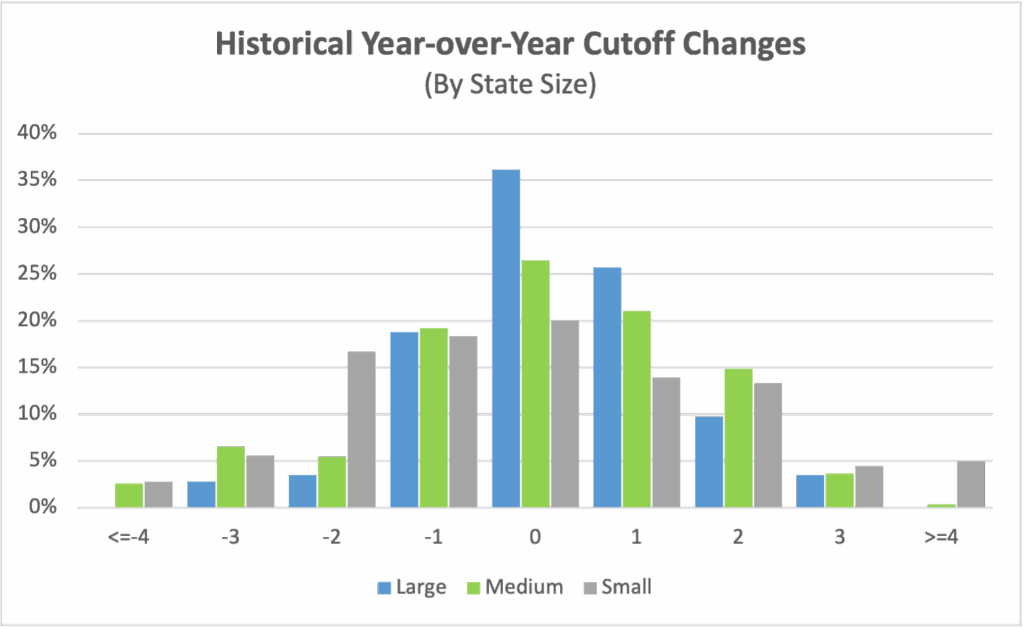
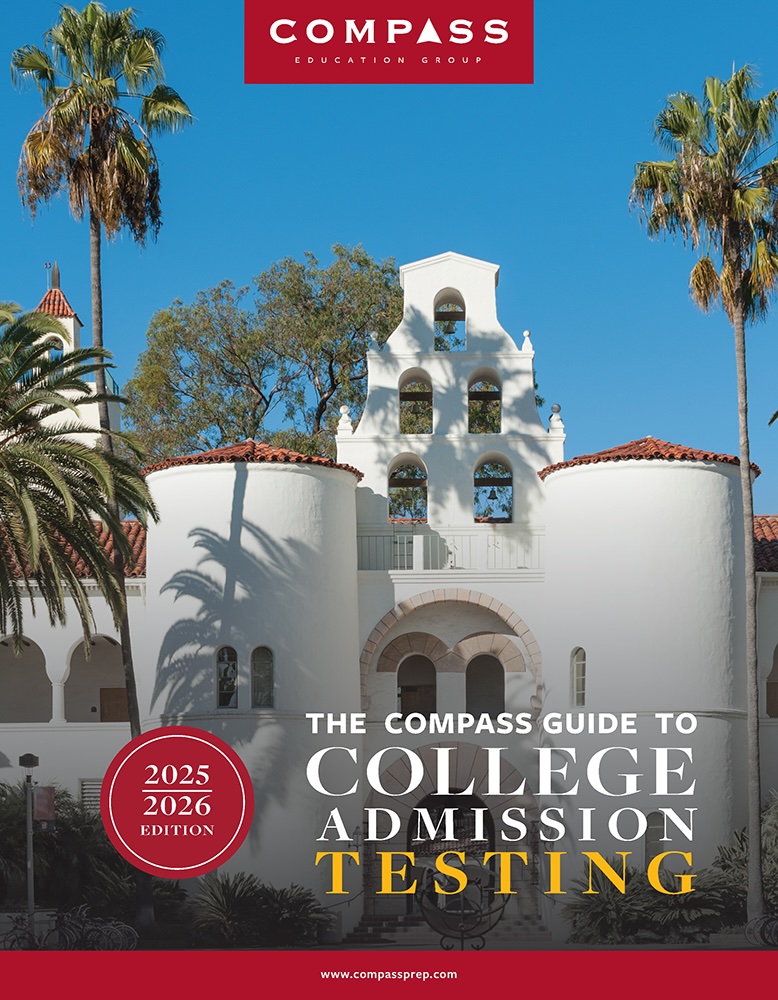
Hi Art,
Do you think the commended cut-off will change?
Thanks
Fernando,
My estimate is now a 208, although I think anything from 207 to 209 is possible.
Hi Art,
What is the likelihood that a 220 selection index qualify in Nevada? Also, in terms of needing a confirming score. Can the SAT from from earlier this year be used? How high does the score need to be? Thank you!
TC,
I think it’s virtually a lock. Nevada has never even made it above 219, and this looks to be a “down” year for most states.
Hi – Will you be updating the projected cutoff scores on this post tonight? How’s South Carolina looking? Thanks for your insight!
JB,
Updated. I only have access to national figures, but scores look low this year. My “most likely” is a 215 for SC, but the Palmetto State has a history of big swings.
Hey Art!
I just checked my score (I live in Oregon) and I got a 1470 on the PSAT NMSQT, and it seems that my index score would be a 219. Any chance that I’d be able to qualify??
J,
It’s definitely possible. Oregon is a tough case because we’ve seen such fluctuations. I think some of the increase last year was due to the high proportion of Alternate Entry qualifiers (because of PSAT cancelations). If we look at the 3 years that look most similar to this year, a 219 would have qualified in two of the three (last year being the exception). It’s close. Good luck!
Hi Art,
Do you think a 216 could qualify for Maine? I am worried about scores bouncing back.
Clint,
Keeping in mind that I don’t get a vote in the matter, I really like your chances with a 218 in Maine. I think it will be closer to 215. I just don’t think we’ll see states hitting new records this year (see my latest updates).
Hi Art,
I got a 1410 and 210 on the PSAT in Ohio. Do you think I will be commended even though I won’t make semifinalist
Rudy,
The relatively low number of high scores in this year’s results leads me to predict a 208 SI for the Commended cutoff. I’m fairly confident that a 210 will qualify.
Hey Art,
Sorry if I’m asking things already brought up in the article, but it looks like you are eager to answer away. I scored a SI of 221 in CT for the class of 2023, so I’m praying that I make that semi finalist cut.
1) When will I be informed if I am a semi finalist?Commended? Is it my principal that will inform me first?
2) Does my extended time (time-and-a-half) accommodation for my 504 plan have any impact on my qualifications?
3) Will you be able to come up with accurate cutoff numbers based on the new test data rolling in today and tomorrow? When does the official NMS board determine/release this?
Thanks
Alex,
All good questions.
1) Semifinalist announcements go out to schools in late August. Yes, your principal will get the list and is responsible for notifications. Students are often not notified until well into September. In theory, Commended students don’t receive official notification until after Semifinalist notifications occur. In practice, the Commended cutoff usually leaks in April, since principals need to work with NMSC in verifying student information over the summer.
2) No.
3) I just posted a major update — probably a few minutes after your comment. The short version is that scores look low this year — good news. The bad news is that there is no way of determining specific state cutoffs with certainty. For anyone close to the estimated ranges, it’s a waiting game until the end of the summer. No Semifinalist numbers are released until announcements go to schools (even then they have to be leaked to folks like me).
Hi! My daughter got a 209 and we are hoping for Commended. Any ideas if scores overall will be consistent with the last two years (207-209) or more in line with the previous 3 years (211-212). Hoping that due to on-line learning, scores are more in line with the last two years.
Thank you!!!
Marie,
I just posted a detailed update that explains why — with score results in hand — I think a Commended cutoff of 208 is likely. I’d be extremely surprised if it went up to 210.
Hi Art
I am from Florida and my index score this year was 219; what do you think the Florida cutoff score will be this year? Thanks.
Graham,
I think Florida will be at 217. Your 219 should be solid!
Thank you for your updated, detailed analysis. My daughter scored a 220 on the PSAT in IL. Given your updated analysis, do you believe the number will come in below your original 220 projection for IL?
Keith,
I’ve probably been a little conservative with Illinois at 220. In down years, it has been at 218 and 219, but it also has a 221 in its history.
Hi Art,
Thank you for the great information. I’m in Louisiana and I got a 1410 and 211. It seems I cleared the commended cut off. What, if any, probability is there that the semifinalist cut off dips to 211? Thanks for your time.
Leon,
Louisiana, I believe, has only twice dipped to 3 points above the Commended level in the last 14 years. A 211 might be a stretch, but it’s not without precedent.
Hi Art,
Thank you for the excellent analysis. Is the chart with your “most likely” predictions by state now updated with new predictions after you saw the national data? Or are you saying just consider the 2017, 2021 and 2022 cutoffs as the most likely comparison? Sitting in Alabama with a 215 and pretty hopeful. Of course I know there are no guarantees but just trying to adjust expectations.
Also, any way of confirming if it was a difficult test this year vs. learning gaps? Will this be analyzed in more detail?
Thanks again!
Kay,
I overwrote the table last night with the wrong data. The one that exists now reflects the lower expected Commended and what that means for the Semifinalist cutoffs.I think Alabama’s numbers went unchanged. A 215 does look strong.
Based on the information available to us, I don’t think there is a way of distinguishing between a difficult test versus learning gaps. The effect would largely be the same unless the learning gaps are unevenly distributed across states (not impossible).
The 216 in the range makes me nervous.
Did you decide to not change your AL prediction because the state mandates the test for all students (so not an issue of who tested)? Or is your prediction based on the other “down” years? Just curious and trying to remain hopeful 🙂
Kay,
The numbers were adjusted based on the “down” year. Do you have a citation for the PSAT mandate? Alabama is traditionally an ACT state, and I only show about 20% of students taking the test pre-pandemic and 15% taking it in 2020.
Sorry, I am wrong. Our school gives it during the school day so it’s greatly encouraged. Maybe it’s the ACT that is required in public schools here.
Ah, that makes sense.
Hi Art!
I am from Alabama, and I was wondering if your predicted selection index cutoff for the state will remain 214, or could it possibly be lower?
Thank you!
Lacey,
It could go lower. In the 3 class years I cite as the best analogues, Alabama’s cutoff has been at 215, 212, and 212.
The 214 is just an estimate. I think Alabama could come in anywhere from 211 to 216.
Hi Art, my student got 221 in overseas category. Will he have a chance to make the Semifinals? Thanks.
DY,
Your student would need a lot of things to fall into place. They don’t just need one state to have had a rough year, they need all of the top states to have had a rough year. It’s unlikely we’ll see that sort of event. It would be possible if scaling at the high end really was quite off from normal.
Hi Art,
Do you think a 220 in California might make it to Semifinalist? Thanks in advance.
Sadie,
Unfortunately, California has locked in on the 221 – 223 range in the last decade. I have a most likely of 222, but neither a 221 nor a 223 would surprise me.
Hi Art,
I’m wondering if your “most likely” prediction for California is 221 or 222? The table above has it at 221 but the post above says 222?
Jay,
The fact that I can so easily confuse myself shows you how much of a tossup I think it is! The 221 is what I am sticking to for now. In down years — which I think we are having — California has been at 221. I’m a broken record on this though: a weak year for the country does not automatically translate into a weak year for every state. I’m afraid you are going to need to wait until you get a tap on the shoulder from your principal in September.
Hi Art!
What do you think the chance of making the cutoff with a 221 in Maryland is?
Thanks!
Noah,
Maryland is one of those states that is so hard to predict — it’s small with a concentrated set of elite students. We’ve seen the cutoff at 221 in the classes of 2017 and 2021, so it’s possible. It does require the assumption that there won’t be another Alternate Entry mess as there was for the class of 2022.
Good morning Art! What a wealth of knowledge you are; as an ACT tutor and National Merit Scholar (1990) I absolutely loved the in-depth detail throughout.
My question is: when the commended cut-off comes out, will that help to further indicate which way state semi-finalist cut-offs are more likely to lean? I.e., would a cut-off of 207 make a low state number more likely? My son has a 214 in Ohio so it’s a nail biter for us.
Janet,
Thank you for the kind words. The current numbers assume a 208 cutoff (note that the table may have been wrong when you checked it). If we see a 207, my basic take would be the same — we are in a down year, but we can’t perfectly predict how that will flow through to an individual state. 214 would be a bit more likely if we see a dip to 207. It’s not out of the question now.
Hi Art
I received a 220 in Illinois. Do you think I have a shot at being a Semifinalist?
GT,
Yes, I think you have a good shot. We’ve seen classes where Illinois’ cutoff hit 221, of course, but I think more states will be on the low side than the high side this year.
Hi, would a 217 make the Kansas cutoff? is there any chances of Kansas jumping to a 218? Thanks!
Evelyn,
While I think there is a good chance that a 217 will qualify in Kansas, I don’t think a 218 can be ruled out.
Thank you for this insightful, well-considered, and meticulous analysis. I read your prior predictions a few weeks ago and just saw this update. I noticed that you didn’t alter your Texas prediction, though the scores are skewing lower. Is there a reason other than the relative stability of larger states? My daughter made a 221 so I going with cautiously optimistic for our mood. Many thanks!
Laura,
I tend toward conservative when moving cutoffs. Until the last couple of years, Texas seemed to be making a move into the group of top-scoring states. If I were to strictly follow guidance from the “low” years, then 220 would seem like the most likely. Your daughter has earned her optimism!
Hi Art — My student took the SAT in August and scored 1560, but had an off day for various reasons on the PSAT and scored a 211 (still hopefully enough to be commended). I know the SAT score is more important for the admission process ahead, but are there any circumstances under which he could submit his SAT score as alternate entry or is that not an option because he’s already taken the PSAT?
RM,
Alternate Entry is not an option when a student has a PSAT on file. Most students would trade a good NM score for a great SAT score, so congratulations to your student!
Hi Art,
Do you think 216 could qualify for Utah? Thanks!
BP,
Yes, a 216 has a high probability of qualifying in Utah this year!
Hi Art,
I scored a 220 in Washington, what are the chances that I make the semifinalist cutoff?
Andrew,
It’s something of a toss-up between a 221 and 220 in my opinion. Maybe 50/50?
Hi Art,
Is a 216 in Washington even a possibility for being in the semifinalist?
Sam,
Washington is a very competitive state. I don’t think 216 will be enough for NMSF.
Hi Art,
I received my score on the PSAT I took this past October and found that I scored a 1520! Since I’ve never even looked into national merit, I have a few questions:
1) Is it (practically) guaranteed that I will at least be a semifinalist?
2) I took the SAT last weekend, and I have about a week to send in free score reports. Should I send one to nmsc even though I technically don’t have confirmation that I will need to send one in?
Thanks!
EC,
1) Um, yes!
2) Go ahead and send. It’s free, and NMSC will use your best scores if you retake and resend.
Hey Art, thanks for the insightful article. I got a 220 and I’m in the top 1%, do you think it’s safe enough for Semifinalist? I know the NY cutoff last year was 220, not sure if I should be optimistic in the cutoff remaining the same.
Thanks
Stanley,
To borrow slang from NCAA basketball: a 220 is on the bubble. Some students like to remain pessimistic and then be pleasantly surprised. Others like to embrace the optimism. Either way, you did a great job and are rewarded with 10 more months of waiting! Good luck.
Hi Art:
How does a 222 in NY look? I know it’s within the range, and the likely is a 221, but I’m trying to gauge how much to temper the getting up of hopes!
August-September feels like an eternity away.
Thank you!
G
G,
I don’t see NY getting to 223. It’s never even made 222, and large states in the 220s don’t make large jumps — especially in a weak year.
HI Art,
What are your thoughts on a 215 qualifying in Missouri? I know your prediction says 216 but I’m wondering if there’s any way to know if that could change based on the recent data. Also, this is my third time trying to post this, so hopefully I don’t look dumb if my other comments all load ;(
thanks.
AI,
I’d argue that my better prediction is that it will fall between 213 and 218. So, yes, I do think 215 has a decent chance of qualifying. If I look at the three years with low Commended cutoffs, Missouri had cutoffs of 214, 214, and 216. Your 215 is in the mix.
Our moderation puts posts in a black hole until they can get approved. Sorry for the inconvenience. Hopefully I haven’t already answered your question 3 times.
Hi Art – very impressed you’re answering everyone on here! My son received 1470 in Oregon with Index of 220. Right on your cut line for Oregon. I’ve been telling him 75% chance to be NMF with that score based (mostly) on your great analysis and write-up. Does that sound like a fair estimation for him?
PG,
Yes, I’d back your estimate. Oregon has only reached 221 once, and that was in a year with a 212 Commended and strong scores across the board. This year doesn’t feel at all like that. On the 25% side is “there is always a state or two that has to ruin things with a surprise.” Let’s hope it is not Oregon.